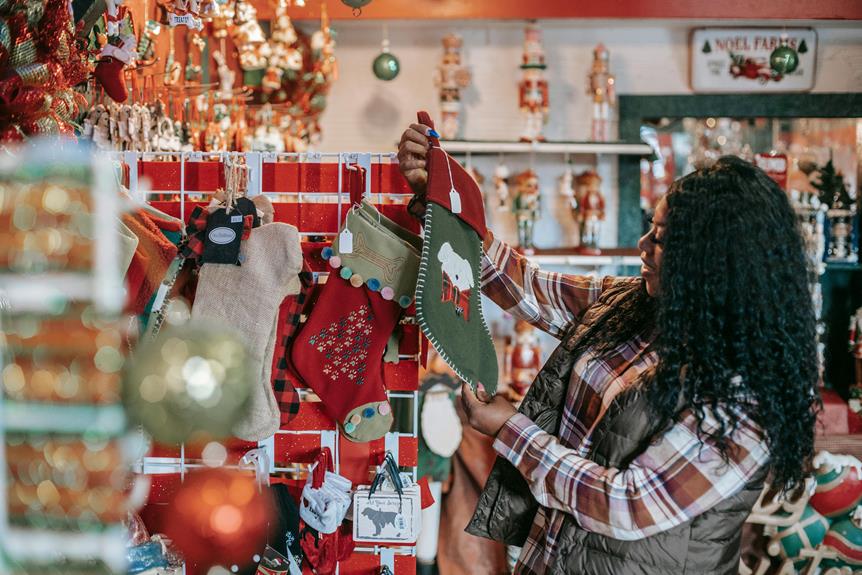You hang stockings by the chimney or on a wall every year, but have you ever wondered why this tradition has become an integral part of your holiday ritual? It all started with Saint Nicholas, a 4th-century bishop known for his kindness and generosity. According to legend, he secretly filled a poor man's daughters' shoes with gold coins, sparking a tradition that would bring joy to children for centuries. Hanging stockings represents the spirit of selfless giving, good luck, and prosperity. As you continue to hang your stockings, you'll discover even more about the rich history and symbolism behind this beloved festive tradition.
Key Takeaways
- Saint Nicholas, a 4th-century bishop, inspired the tradition of Christmas stockings by secretly filling a poor man's daughters' shoes with gold coins.
- Hanging stockings symbolizes good luck, prosperity, and the values of kindness and generosity, which are core to the holiday season.
- The tradition of hanging stockings originated from ancient practices of gift-giving, which was a symbol of goodwill, friendship, and social status.
- Stockings represent the idea of humble, selfless giving and create a space for others to show their appreciation and love through small gifts or notes.
- The tradition of hanging stockings has evolved over time, accommodating modern tastes and living spaces, but remains a beloved part of the holiday experience.
The Legend of Saint Nicholas
You're likely familiar with the legendary figure of Saint Nicholas, a 4th-century bishop of Myra, who secretly left gifts for those in need, earning him a reputation as a bringer of joy and benefactor of children.
This kind-hearted bishop was known for his generosity and kindness, often going out of his way to help those in need. As a result, he became known as a Miracle Worker, and his reputation spread far and wide.
As the Holy Patron of children, sailors, and many others, Saint Nicholas was revered for his selflessness and compassion.
His feast day, December 6th, is still celebrated in many countries, where children receive gifts and treats in honor of this beloved saint.
In many cultures, Saint Nicholas is seen as a symbol of hope and generosity, reminding us of the importance of kindness and charity.
His legacy has endured for centuries, inspiring countless people around the world to follow in his footsteps and spread joy and happiness to those around them.
The History of Gift Giving
As you wrap up gifts for your loved ones, have you ever wondered where this tradition of gift-giving originated?
Giving gifts during the holiday season has its roots in ancient traditions, where people would exchange presents as a symbol of goodwill and friendship. In ancient cultures, gift-giving was an essential part of social and economic relationships, known as the Gift Economy.
This system was based on reciprocity, where gifts were exchanged to strengthen bonds, settle debts, and demonstrate social status.
In many Ancient Practices, gifts were also offered to gods and goddesses as a token of gratitude and respect.
The tradition continued through the ages, with the early Christians adopting it as a way to celebrate the birth of Jesus Christ.
As you give gifts this holiday season, you're continuing a tradition that dates back thousands of years. You're not just exchanging presents; you're strengthening relationships, showing appreciation, and perpetuating a tradition that's been passed down through generations.
Stockings as a Symbol
Hanging stockings by the chimney or on a wall has become an integral part of holiday decor, but have you ever stopped to think about what they symbolize?
As you hang yours, you're participating in a tradition that's rich in meaning. For one, stockings are a symbol of good luck. In many cultures, it's believed that receiving gifts in a stocking brings prosperity and fortune in the coming year. This idea is rooted in the legend of Saint Nicholas, who was known for secretly leaving gifts in children's shoes.
Beyond good luck, stockings also hold spiritual significance. They represent the idea of humble, selfless giving – a core value of the holiday season.
When you hang a stocking, you're acknowledging the importance of kindness and generosity. You're also creating a space for others to show their appreciation and love for you, whether it's through small gifts or heartfelt notes.
The Origins of Christmas Stockings
According to legend, Saint Nicholas, a 4th-century bishop, inspired the tradition of Christmas stockings when he secretly filled a poor man's daughters' shoes with gold coins to save them from a life of slavery. This selfless act sparked a tradition that would bring joy and excitement to children for centuries to come.
As you hang your stockings by the chimney with care, you're continuing a tradition that's steeped in Christmas magic and holiday nostalgia. You're not just hanging a piece of cloth, you're connecting with a tradition that's been passed down through generations. You're keeping alive the spirit of generosity and kindness that Saint Nicholas embodied.
When you hang your stockings, you're also tapping into the excitement and anticipation of Christmas morning. You're imagining the surprise and delight on your children's faces when they discover the treats and goodies that Santa has left for them. So, go ahead, hang those stockings with pride, and let the magic of the season fill your heart!
A Story of Generosity and Kindness
A Story of Generosity and Kindness
By filling the poor man's daughters' shoes with gold coins, Saint Nicholas demonstrated a selfless act of generosity that would inspire a Christmas tradition for centuries to come.
You might wonder what sparked this benevolent gesture. According to legend, Saint Nicholas learned about a poor man's struggles to provide for his daughters, and he wanted to help. Without expecting anything in return, he performed a random act of kindness that changed the family's life forever.
Saint Nicholas's selfless deeds didn't go unnoticed. His reputation as a bringer of gifts and a champion of the poor spread quickly.
As you celebrate Christmas, remember the significance of Saint Nicholas's actions. His generosity and kindness inspire us to perform similar acts of charity during the holiday season.
You can continue this tradition by engaging in random acts of kindness, no matter how small they may seem. Whether it's donating to a local food bank or volunteering at a homeless shelter, your selfless deeds can bring joy to those around you.
The Influence of European Folklore
As Saint Nicholas's legend spread throughout Europe, it merged with local folklore, transforming him into a mythical figure associated with gift-giving and winter festivities. You can see the influence of European folklore in the way Saint Nicholas's story blended with existing traditions.
In many cultures, the Winter Solstice marked a time of celebration and gift-giving, and Saint Nicholas's reputation as a bringer of gifts fit perfectly into these existing customs.
In some European cultures, folkloric creatures like elves and gnomes were believed to be mischievous spirits that roamed the countryside during the winter months. These creatures were often associated with the Winter Solstice and were said to play tricks on humans during this time.
As Saint Nicholas's legend grew, he became linked to these folkloric creatures, and they became his helpers, assisting him in his gift-giving duties.
You can still see the influence of European folklore in the way we celebrate Christmas today.
From the idea of elves working in Santa's workshop to the tradition of leaving out treats for Saint Nicholas on Christmas Eve, the legacy of European folklore lives on in our holiday traditions.
The Tradition Takes Shape
By the 16th century, the custom of hanging stockings by the chimney with care had become an integral part of the Saint Nicholas legend, symbolizing the humble beginnings of a gift-giving tradition.
As you imagine the scene, you're probably picturing a cozy family gathering, with parents and children anxiously awaiting the arrival of Saint Nicholas. This is exactly what was happening in many European households, where family dynamics played a significant role in shaping the tradition.
You see, the practice of hanging stockings was often a family affair, with parents and children working together to prepare for the saint's visit. This collaborative effort fostered a sense of unity and togetherness, reinforcing the importance of family bonds during the holiday season.
Additionally, the tradition also reflects a cultural fusion of sorts, blending elements of European folklore with the legend of Saint Nicholas.
As you participate in this tradition today, you're part of a rich cultural heritage that has evolved over centuries, weaving together stories, customs, and values from diverse backgrounds.
Stockings Become a Christmas Staple
You're likely familiar with the iconic image of stockings hung by the chimney, but have you ever wondered how this tradition made its way into the fabric of Christmas celebrations?
As the 19th century rolled around, stockings became a staple of Christmas decorations, and it wasn't just about functionality anymore. The tradition had evolved to include fashion trends, with stockings becoming a statement piece in many homes. They were often intricately designed, colorful, and made of fine materials, making them a cultural icon of the season.
As Christmas cards and advertisements began to feature stockings prominently, the image became synonymous with the holiday. You might've even seen illustrations of jolly old Saint Nick himself, filling stockings with goodies for children to discover on Christmas morning.
The idea of waking up to find your stocking filled with treats became a magical part of the holiday experience, and the tradition solidified its place in Christmas folklore. Today, hanging stockings by the chimney remains a beloved tradition, a tribute to the power of nostalgia and the enduring charm of this festive symbol.
Hanging Stockings Today
Today, you hang stockings in anticipation of Christmas morning, perpetuating a tradition that has evolved to accommodate modern tastes and living spaces.
You might choose to hang them by the chimney with care, or opt for a more modern approach, such as using a stocking holder or adhesive hooks on a wall or window.
Whatever the method, the excitement of waking up to find your stocking filled with treats and small gifts remains a beloved part of the holiday experience.
As you decorate your home with modern decorations, such as LED lights, garlands, and ornaments, you're likely to include stockings as a key element of your festive display.
Hanging stockings has become an integral part of many family rituals, with each member of the household having their own personalized stocking.
You might even make it a fun activity, letting each person decorate their own stocking with names, glitter, and other embellishments.
Whether you're continuing a long-standing tradition or starting a new one, hanging stockings is a simple yet meaningful way to add to the magic of the holiday season.
Frequently Asked Questions
What Is the Best Way to Hang Stockings on a Fireplace Mantel?
You'll want to hang stockings at a comfortable height on your fireplace mantel, about 6-8 inches apart. Use stocking clips to securely hold them in place, ensuring they don't slip or fall during the holiday season.
Can Stockings Be Used as a Decoration Without Gifts Inside?
You can totally use stockings as a decoration without gifts inside, creating a beautiful Stocking Garland along your mantel or staircase. Empty elegance can be just as charming, adding a festive touch to your holiday decor.
How Many Stockings Can Fit on a Standard Stocking Holder?
You can fit a million stockings on a standard holder, but realistically, it depends on the holder's dimensions and stocking capacity. Typically, a standard holder can fit 4-6 stockings, depending on their size and the holder's width.
Are There Any Specific Rules for What to Put in a Stocking?
When filling your stocking, you'll want to follow some gift guidelines to guarantee a delightful surprise. Aim for a mix of small treats, fun trinkets, and practical items, avoiding anything too bulky or expensive, to create a stocking full of joyful surprises.
Can Stockings Be Used as a Gift Wrapping Alternative?
You're looking for an eco-friendly twist on gift wrapping! Yes, you can use stockings as a creative packaging alternative, filling them with goodies and gifting them as a fun, reusable eco wrapping solution.
Conclusion
You've unwrapped the origins of hanging stockings, and now you're a part of a tradition that's been woven into the fabric of Christmas magic for centuries!
Imagine the collective joy of millions of children (and let's be honest, adults too!) who've hung their stockings by the chimney with care, hoping for a glimpse of Saint Nick's generosity.
It's a tradition that's been passed down through generations, filling hearts with wonder and homes with laughter – and it all started with a simple act of kindness.


